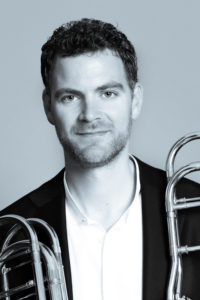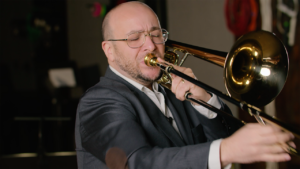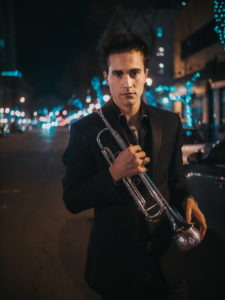Robert Sanders – Trombone Interview

Welcome to the show notes for Episode #4 of the Trombone Corner podcast. This episode features bass trombonist Robert Sanders.
Listen to or download the episode below:
Podcast: Play in new window | Download
About Robert Sanders
 Bob‘s training included four great teachers, Don Kimble, Jeff Reynolds, Robert Simmergren and Roy Main; they have made all the difference! His professional career began at the age of twenty with the Disneyland Band where he stayed three years. It was a de facto apprenticeship, working day in and day out with 15 experienced professional musicians. Thereafter he stayed busy performing hither and yon in the greater Los Angeles area, including 30 years with Pacific Symphony, 24 years as a founding member of the Hollywood Bowl Orchestra, 22 seasons with Opera Pacific, 12 years in the Composers Brass Quintet, and of course, a decade or so in Hoyt Bohannon’s garage on Tuesday nights.
Bob‘s training included four great teachers, Don Kimble, Jeff Reynolds, Robert Simmergren and Roy Main; they have made all the difference! His professional career began at the age of twenty with the Disneyland Band where he stayed three years. It was a de facto apprenticeship, working day in and day out with 15 experienced professional musicians. Thereafter he stayed busy performing hither and yon in the greater Los Angeles area, including 30 years with Pacific Symphony, 24 years as a founding member of the Hollywood Bowl Orchestra, 22 seasons with Opera Pacific, 12 years in the Composers Brass Quintet, and of course, a decade or so in Hoyt Bohannon’s garage on Tuesday nights.

The low brass section from Zorro.
He has played on a freelance basis, at one time or another, for every dog and pony show to come through Southern California for 45 years; including the Los Angeles Philharmonic, hundreds of motion picture and television scores, and considerable time in various and sundry theater, ballet and opera pits. He has been a member of the Bill Watrous Refuge West Band, the Jack Sheldon Orchestra, the Jimmy Cleveland Orchestra and did two, all too short, tours subbing with the west coast iteration of the Toshiko Akioshi-Lew Tabackin Big Band.
He is presently retired from low brass performance, serves as president of Local 7, American Federation of Musicians, and has taught trombone at California State University, Fullerton for more than three decades; where he co-founded (with Jeannie Little and Alex Iles) Trombone Day in 2004.
Bob is a Greenhoe Artist.
Robert Sanders Links
Podcast Credits
- Theme Music: The Trombone Choir Arrangements of Jay Friedman, Vol. 1
- Audio Engineer – Preston Shepard at SC Sound Labs
- Cover Art – Frank Gladstone
- Podcast Hosts – Noah Gladstone & John Snell








 Jay Friedman attended Yale University on scholarship and majored in composition at Roosevelt University. After four years with the Civic Orchestra of Chicago and two years with the Florida Symphony, he joined the Chicago Symphony Orchestra in 1962 and was appointed principal trombone in 1964. He has soloed with the CSO on several occasions, including a concerto by Ellen Taaffe Zwilich.
Jay Friedman attended Yale University on scholarship and majored in composition at Roosevelt University. After four years with the Civic Orchestra of Chicago and two years with the Florida Symphony, he joined the Chicago Symphony Orchestra in 1962 and was appointed principal trombone in 1964. He has soloed with the CSO on several occasions, including a concerto by Ellen Taaffe Zwilich. Friedman’s conducting career has included guest appearances with orchestras around the world, including the Orchestra of the Italian Radio (RAI), the Malmo Symphony, and the Chicago Symphony Orchestra’s annual donor concerts. In April 2005, he conducted three concerts with the Santa Cecilia Orchestra of Rome. In March 2006, he conducted the Civic Orchestra of Chicago in a public master class of Mahler’s Fifth Symphony at Symphony Center, and in May 2007 he conducted the RAI orchestra in Italy with Daniel Barenboim as piano soloist.
Friedman’s conducting career has included guest appearances with orchestras around the world, including the Orchestra of the Italian Radio (RAI), the Malmo Symphony, and the Chicago Symphony Orchestra’s annual donor concerts. In April 2005, he conducted three concerts with the Santa Cecilia Orchestra of Rome. In March 2006, he conducted the Civic Orchestra of Chicago in a public master class of Mahler’s Fifth Symphony at Symphony Center, and in May 2007 he conducted the RAI orchestra in Italy with Daniel Barenboim as piano soloist.
 Honesty Pill founder Christopher Still joined the Los Angeles Philharmonic as Second Trumpet in 2007.
Honesty Pill founder Christopher Still joined the Los Angeles Philharmonic as Second Trumpet in 2007.
 David Elton is recognised as one of the world’s most sought-after trumpet players.
David Elton is recognised as one of the world’s most sought-after trumpet players. David is an active chamber musician, most recently giving the world premiere of David Sampson’s Memories to Keep Awhile at the Australian Festival of Chamber Music. He is a founding member of the Australian Brass Quintet with whom he regularly tours throughout Australia and beyond.
David is an active chamber musician, most recently giving the world premiere of David Sampson’s Memories to Keep Awhile at the Australian Festival of Chamber Music. He is a founding member of the Australian Brass Quintet with whom he regularly tours throughout Australia and beyond.

 Martin appeared as teacher and soloist on festivals such as the International Trombone Festival, Korean Trombone Symposium, Dutch Bass Trombone Open, Festival do Campos Jordao Brazil, Costa Rica Trombone Festival, Thailand Trombone Festival, Jeju International Wind Ensemble Festival, Sesc International Music Festival Pelotas Brazil, IPV Festival, Lätzsch Trombone Festival, Curso Trombon de Valga in Spain amongst others and taught masterclasses at major universities in USA, Europe, Australia and Asia.
Martin appeared as teacher and soloist on festivals such as the International Trombone Festival, Korean Trombone Symposium, Dutch Bass Trombone Open, Festival do Campos Jordao Brazil, Costa Rica Trombone Festival, Thailand Trombone Festival, Jeju International Wind Ensemble Festival, Sesc International Music Festival Pelotas Brazil, IPV Festival, Lätzsch Trombone Festival, Curso Trombon de Valga in Spain amongst others and taught masterclasses at major universities in USA, Europe, Australia and Asia.
 Originally from Portland Oregon, Gary Guthman started his career at the age of nine. As a young teen, Gary was a member of the nationally acclaimed “Seldom Six” Dixieland Band, comprised of 12 to 14 years old who traveled the United States performing stage shows and conventions, playing, singing and tap-dancing all the way. Throughout Gary’s high school and college years, he performed with jazz and rock and roll bands and at 17 years old, auditioned for the acclaimed Portland (Oregon) Youth Orchestra; the oldest of its kind in the United States.
Originally from Portland Oregon, Gary Guthman started his career at the age of nine. As a young teen, Gary was a member of the nationally acclaimed “Seldom Six” Dixieland Band, comprised of 12 to 14 years old who traveled the United States performing stage shows and conventions, playing, singing and tap-dancing all the way. Throughout Gary’s high school and college years, he performed with jazz and rock and roll bands and at 17 years old, auditioned for the acclaimed Portland (Oregon) Youth Orchestra; the oldest of its kind in the United States. Since moving to Central Europe, Gary has given hundreds of concerts with his “Gary Guthman Quartet” and “The New Swing Orchestra”, as well as Symphonic Pops concerts. In 2011, Gary released his next CD entitled “Solar Eclipse” on the Polski Radio Jazz Label, featuring his quartet of world-class Polish jazz artists Filip Wojciechowski/piano, Paweł Pańta/Bass, Cezary Konrad/Drums. Gary Guthman is the only non-Polish jazz artist to release his own CD in the 95-year history of Polish Radio. In 2014, along with his co-writer Doman Nowakowski, Gary composed the Libretto, Music and Lyrics for a new musical entitled “Letter from Warsaw”.
Since moving to Central Europe, Gary has given hundreds of concerts with his “Gary Guthman Quartet” and “The New Swing Orchestra”, as well as Symphonic Pops concerts. In 2011, Gary released his next CD entitled “Solar Eclipse” on the Polski Radio Jazz Label, featuring his quartet of world-class Polish jazz artists Filip Wojciechowski/piano, Paweł Pańta/Bass, Cezary Konrad/Drums. Gary Guthman is the only non-Polish jazz artist to release his own CD in the 95-year history of Polish Radio. In 2014, along with his co-writer Doman Nowakowski, Gary composed the Libretto, Music and Lyrics for a new musical entitled “Letter from Warsaw”.
 David Rejano is the principal trombone of the Los Angeles Philharmonic Orchestra since 2016. Before that, he served as Principal Trombone with the Orquestra Sinfonica de Navarra from 2002 to 2007, Principal Trombone with the Orquestra del Gran Teatro del Liceo de Barcelona (Barcelona Opera House) from 2007 to 2010, and Principal Trombone with the Münchner Philharmoniker from 2010 to 2016.
David Rejano is the principal trombone of the Los Angeles Philharmonic Orchestra since 2016. Before that, he served as Principal Trombone with the Orquestra Sinfonica de Navarra from 2002 to 2007, Principal Trombone with the Orquestra del Gran Teatro del Liceo de Barcelona (Barcelona Opera House) from 2007 to 2010, and Principal Trombone with the Münchner Philharmoniker from 2010 to 2016. David Rejano (1982) was born in Badajoz /Spain/, and initially studied music at the Conservatory in Madrid. Then he moved to the Conservatoire National Supérieur de Musique et de Danse de Paris, with professor Gilles Millière, where he graduated with the “Diplôme de Formation Supérieur – Mention très bien à l’unanimité” and the “Prix Spécial du Jury”. He was a member of the European Union Youth Orchestra -EUYO- and the West-Eastern Divan Orchestra -WEDO- (with Daniel Barenboim and Pierre Boulez).
David Rejano (1982) was born in Badajoz /Spain/, and initially studied music at the Conservatory in Madrid. Then he moved to the Conservatoire National Supérieur de Musique et de Danse de Paris, with professor Gilles Millière, where he graduated with the “Diplôme de Formation Supérieur – Mention très bien à l’unanimité” and the “Prix Spécial du Jury”. He was a member of the European Union Youth Orchestra -EUYO- and the West-Eastern Divan Orchestra -WEDO- (with Daniel Barenboim and Pierre Boulez).
 Tom Clary is a freelance trumpet-player/composer/
Tom Clary is a freelance trumpet-player/composer/ Tom eventually finished his music degree in 2002 and went on to complete a law degree at the University of Memphis in 2005. He practiced law full-time for approximately 13 years. He still maintains a very-small law practice, but has returned to play and write music full-time, while making and selling trumpet mutes out of wood in his garage.
Tom eventually finished his music degree in 2002 and went on to complete a law degree at the University of Memphis in 2005. He practiced law full-time for approximately 13 years. He still maintains a very-small law practice, but has returned to play and write music full-time, while making and selling trumpet mutes out of wood in his garage.
 If you ever have the opportunity to see Nathan Samuelson perform, prepare to be taken on a musical odyssey. His music is imbued with wanderlust —inspired by years at sea and a careful balancing act between new horizons and the love of home. Audiences are sonically teleported to the tropical shores of Brazil, the cosmopolitan streets of New York, and the old world sophistication of Europe. Despite the many nautical miles he’s logged, his music maintains the wholesome honesty of his prairie boyhood. That sweet earnestness and approachability is what turns audiences of strangers into loyal fans.
If you ever have the opportunity to see Nathan Samuelson perform, prepare to be taken on a musical odyssey. His music is imbued with wanderlust —inspired by years at sea and a careful balancing act between new horizons and the love of home. Audiences are sonically teleported to the tropical shores of Brazil, the cosmopolitan streets of New York, and the old world sophistication of Europe. Despite the many nautical miles he’s logged, his music maintains the wholesome honesty of his prairie boyhood. That sweet earnestness and approachability is what turns audiences of strangers into loyal fans.  He has graced stages in exotic locales such as Brazil, Croatia, Italy, Greece, France, Portugal, England, Spain and more. To add, he shared these stages with world class artists like late soul icon Clem Curtis [The Foundations] of “Build Me Up, Buttercup” fame. He has also performed with Leanne Mitchell, winner of the first series of The Voice UK, and international soul singer, Lloyd Wade. In his home community of Edmonton, Alberta he is often found volunteering his talent for children and youth, as well as people living with disability. When not volunteering, he can be found performing as a guest artist on cruise ships, and performing with his own quintet at various jazz festivals and corporate events.
He has graced stages in exotic locales such as Brazil, Croatia, Italy, Greece, France, Portugal, England, Spain and more. To add, he shared these stages with world class artists like late soul icon Clem Curtis [The Foundations] of “Build Me Up, Buttercup” fame. He has also performed with Leanne Mitchell, winner of the first series of The Voice UK, and international soul singer, Lloyd Wade. In his home community of Edmonton, Alberta he is often found volunteering his talent for children and youth, as well as people living with disability. When not volunteering, he can be found performing as a guest artist on cruise ships, and performing with his own quintet at various jazz festivals and corporate events.  This list was cultivated by studio legend Gary Grant and posted on our original website in 1996! We thought it was lost in cyberspace but thankfully found it on a backup.
This list was cultivated by studio legend Gary Grant and posted on our original website in 1996! We thought it was lost in cyberspace but thankfully found it on a backup.



